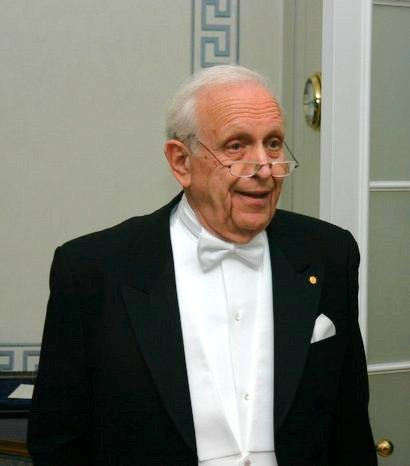- Roy J. Glauber
Infobox_Scientist
name = Roy J. Glauber

imagesize = 200px
birth_date = Birth date and age|1925|9|1|df=yes
birth_place =New York City, New York , USA
residence =United States
nationality =United States
field =Physics
work_institution =Harvard University
alma_mater =Harvard University
doctoral_advisor =Julian Schwinger
doctoral_students =Daniel Frank Walls
known_for = Photodetection,quantum optics
societies =
prizes = nowrap|Nobel Prize in Physics (2005)
religion =
footnotes =Roy Jay Glauber (born
1 September 1925 ) is an American theoreticalphysicist . He is theMallinckrodt Professor ofPhysics atHarvard University and Adjunct Professor of Optical Sciences at theUniversity of Arizona . Born inNew York City , he was awarded one half of the 2005Nobel Prize in Physics "for his contribution to the quantum theory of optical coherence", with the other half shared byJohn L. Hall andTheodor W. Hänsch .In this work, published in 1963, he created a model for
photodetection and explained the fundamental characteristics of different types of light, such aslaser light (seecoherent state ) and light from light bulbs (seeblackbody ). His theories are widely used in the field ofquantum optics .Biography
Glauber was born in 1925 in
New York City , a member of the 1941 graduating class of theBronx High School of Science , and went on to do his undergraduate work atHarvard University . After his sophomore year he was recruited to work on theManhattan Project , where (at the age of 18) he was one of the youngest scientists atLos Alamos . His work involved calculating thecritical mass for theatom bomb . After two years at Los Alamos, he returned to Harvard, receiving his bachelor's degree in 1946 and his PhD in 1949.Glauber has received many honors for his research, including the
A. A. Michelson Medal from theFranklin Institute inPhiladelphia (1985), theMax Born Award from theOptical Society of America (1985), theDannie Heineman Prize for Mathematical Physics from theAmerican Physical Society (1996), and the 2005Nobel Prize in Physics . On the 22th of April 2008, Professor Glauber was awarded the 'Medalla de Oro delCSIC ' ('CSIC's Gold Medal') in a ceremony held inMadrid, Spain . [cite web|url=http://www.csic.es/documentos/destacados/medalla_csic08.pdf|title=Nota informativa acto de entrega de la medalla de Oro del CSIC al profesor Roy J. Glauber | accessdate=2008-04-23]He currently lives in
Arlington, Massachusetts and is the Mallinckrodt Professor of Physics at Harvard University, where both past and present students enthusiastically praised his teaching toHarvard Crimson reporters.Glauber has two children, a son and a daughter, and five grandchildren.
Recent Work
Roy Glauber's recent research has dealt with problems in a number of areas of quantum optics, a field which, broadly speaking, studies the
quantum electrodynamic al interactions of light and matter. He is also continuing work on several topics in high-energy collision theory, including the analysis ofhadron collisions, and the statistical correlation of particles produced in high-energy reactions.Specific topics of his current research include: the quantum mechanical behavior of trapped
wave packet s; interactions of light with trapped ions; atom counting-the statistical properties of free atom beams and their measurement; algebraic methods for dealing withfermion statistics; coherence and correlations ofbosonic atom s near theBose-Einstein condensation ; the theory of continuously monitored photon counting-and its reaction on quantum sources; the fundamental nature of “quantum jump s”; resonant transport of particles produced multiply in high-energy collisions; the multiple diffraction model of proton-proton and proton-antiproton scattering.Works by Glauber
R. J. Glauber, "Quantum Theory of Optical Coherence. Selected Papers and Lectures", Wiley-VCH, Weinheim 2007. (A collection of reprints of Glauber's most important papers from 1963 to 1999, selected by the author.)
Trivia
For many years before winning his Nobel Prize, Glauber was familiar to audiences of the
Ig Nobel Prize ceremonies, where he took a bow each year as "Keeper of the Broom," sweeping the stage clean of thepaper airplane s that have traditionally been thrown during the event. He missed the 2005 event, though, as he was being awarded his real Nobel Prize at the time.References
External links
* [http://web.ift.uib.no/AMOS/MOV/HO/ Glauber States: Coherent states of Quantum Harmonic Oscillator]
* [http://www.physics.harvard.edu/people/facpages/glauber.html Roy J. Glauber at the Harvard Physics Department Faculty website]
* [http://nobelprize.org/physics/laureates/2005/index.html The Nobel Prize in Physics 2005]
* [http://www.aps.org/praw/heineman/96winner.cfm Dannie Heineman Prize 1996]
* [http://www.thecrimson.com/article.aspx?ref=508806 "Physics Professor Awarded Nobel", "Harvard Crimson", October 5, 2005]
* [http://education.guardian.co.uk/higher/research/story/0,9865,1588945,00.html "Double Honours", "Guardian", October 11, 2005]
* [http://www.city-journal.org/html/9_2_how_gothams_elite.html NYC High Schools]Persondata
NAME=Glauber, Roy Jay
ALTERNATIVE NAMES=
SHORT DESCRIPTION=American physicist
DATE OF BIRTH=1 September 1935
PLACE OF BIRTH=New York City ,New York , U.S.
DATE OF DEATH=
PLACE OF DEATH=
Wikimedia Foundation. 2010.
